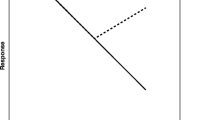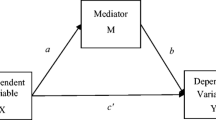Abstract
Coping Power is an evidence-based preventive intervention for youth with aggressive behavior problems that has traditionally been delivered in small group formats, but because of concerns about potentially diminished effects secondary to aggregation of high-risk youth, an individual format of Coping Power has been developed. The current study examined whether physiological characteristics of the child may provide information about which intervention delivery format works best for that individual. Indicators of sympathetic and parasympathetic nervous system functioning were examined in 360 fourth-grade children (65% male; 76.4% self-reported African-American) who were randomly assigned to Group Coping Power (GCP) or Individual Coping Power (ICP) (Lochman et al. 2015). Longitudinal assessments of teacher- and parent-reported proactive and reactive aggression were collected through a 1-year follow-up. For children with higher initial levels of aggression, those with lower parasympathetic functioning at pre-intervention showed greater reductions in teacher-rated proactive aggression in the ICP condition than the GCP condition. For children with high parasympathetic functioning, there was no differential effect of intervention format. Regardless of intervention format, youth with lower levels of sympathetic functioning at pre-intervention demonstrated greater reductions in teacher-rated proactive aggression. These findings suggest that physiological indicators may be worth considering in future studies examining which youth respond best to specific types of interventions.


Similar content being viewed by others
References
Abaied, J. L. (2016). Skin conductance level reactivity as a moderator of the link between parent depressive symptoms and psychosocial adjustment in emerging adults. Journal of Social and Personal Relationships, 33, 534–556. https://doi.org/10.1177/0265407515583170.
Albert, D., Belsky, D. W., Crowley, D. M., Latendresse, S. J., Aliev, F., Riley, B., et al. (2015). Can genetics predict response to complex behavioral interventions? Evidence from a genetic analysis of the fast track randomized control trial. Journal of Policy Analysis and Management, 34, 497–518. https://doi.org/10.1002/pam.21811.
Beauchaine, T. P. (2001). Vagal tone, development, and Gray's motivational theory: toward an integrated model of autonomic nervous system functioning in psychopathology. Development and Psychopathology, 13, 183–214.
Beauchaine, T. P. (2015). Respiratory sinus arrhythmia: a transdiagnostic biomarker of emotion dysregulation and psychopathology. Current Opinion in Psychology, 3, 43–47.
Beauchaine, T. P., Neuhaus, E., Gatzke-Kopp, L. M., Reid, M. J., Chipman, J., Brekke, A., et al. (2015). Electrodermal responding predicts responses to, and may be altered by, preschool intervention for ADHD. Journal of Consulting and Clinical Psychology, 83, 293–303. https://doi.org/10.1037/a0038405.
Clark, C. A., Skowron, E. A., Giuliano, R. J., & Fisher, P. A. (2016). Intersections between cardiac physiology, emotion regulation and interpersonal warmth in preschoolers: implications for drug abuse prevention from translational neuroscience. Drug and Alcohol Dependence, 163, S60–S69. https://doi.org/10.1016/j.drugalcdep.2016.01.033.
Cummings, E. M., El-Sheikh, M., Kouros, C. D., & Keller, P. S. (2007). Children’s skin conductance reactivity as a mechanism of risk in the context of parental depressive symptoms. Journal of Child Psychology and Psychiatry, 48, 436–445. https://doi.org/10.1111/j.1469-7610.2006.01713.x.
Denver, J. W., Reed, S. F., & Porges, S. W. (2007). Methodological issues in the quantification of respiratory sinus arrhythmia. Biological Psychology, 74, 286–294. https://doi.org/10.1016/j.biopsycho.2005.09.005.
Dishion, T. J., & Tipsord, J. M. (2011). Peer contagion in child and adolescent social and emotional development. Annual Review of Psychology, 62, 189–214. https://doi.org/10.1146/annurev.psych.093008.100412.
Dodge, K. A. (2009). Community intervention and public policy in the prevention of antisocial behavior. Journal of Child Psychology and Psychiatry, and Allied Disciplines, 50, 194–200.
Dodge, K. A., & Coie, J. D. (1987). Social-information processing factors in reactive and proactive aggression in children’s peer groups. Journal of Personality and Social Psychology, 53, 1146–1158.
Dodge, K. A., Lochman, J. E., Harnish, J. D., Bates, J. E., & Pettit, G. S. (1997). Reactive and proactive aggression in school children and psychiatrically impaired chronically assaultive youth. Journal of Abnormal Psychology, 106, 37–51. https://doi.org/10.1037/0021-843X.106.1.37.
Dodge, K. A., Dishion, T. J., & Landsford, J. E. (2006). Deviant peer influences in programs for youth: problems and solutions. New York: Guilford Press.
Eisenberg, N., Fabes, R. A., Murphy, B., Maszk, P., Smith, M., & Karbon, M. (1995). The role of emotionality and regulation in children’s social functioning: a longitudinal study. Child Development, 66, 1360–1384.
Erath, S. A., Tu, K. M., & El-Sheikh, M. (2012). Socially anxious and peer-victimized preadolescents: “doubly primed” for distress? Journal of Abnormal Child Psychology, 40, 837–848. https://doi.org/10.1007/s10802-011-9600-9.
Fabes, R. A., & Eisenberg, N. (1997). Regulatory control and adults’ stress-related responses to daily life events. Journal of Personality and Social Psychology, 73, 1107–1117.
Fortunato, C. K., Gatzke-Kopp, L. M., & Ram, N. (2013). Associations between respiratory sinus arrhythmia reactivity and internalizing and externalizing symptoms are emotion specific. Cognitive, Affective, & Behavioral Neuroscience, 13, 238–251. https://doi.org/10.3758/s13415-012-0136-4.
Gatzke-Kopp, L. M., Raine, A., Loeber, R., Stouthamer-Loeber, M., & Steinhauer, S. R. (2002). Serious delinquent behavior, sensation seeking, and electrodermal arousal. Journal of Abnormal Child Psychology, 30, 477–486. https://doi.org/10.1023/a:1019816930615.
Gatzke-Kopp, L. M., Greenberg, M., & Bierman, K. (2015). Children’s parasympathetic reactivity to specific emotions moderates response to intervention for early-onset aggression. Journal of Clinical Child and Adolescent Psychology, 44, 291–304. https://doi.org/10.1080/15374416.2013.862801.
Gazelle, H., & Druhen, M. J. (2009). Anxious solitude and peer exclusion predict social helplessness, upset affect, and vagal regulation in response to behavioral rejection by a friend. Developmental Psychololgy, 45, 1077–1096. https://doi.org/10.1037/a0016165.
Goodnight, J. A., Bates, J. E., Newman, J. P., Dodge, K. A., & Pettit, G. S. (2006). The interactive influences of friend deviance and reward dominance on the development of externalizing behavior during middle adolescence. Journal of Abnormal Child Psychology, 34, 573–583.
Gregson, K. D., Tu, K. M., & Erath, S. A. (2014). Sweating under pressure: skin conductance level reactivity moderates the association between peer victimization and externalizing behavior. Journal of Child Psychology and Psychiatry, 55, 22–30. https://doi.org/10.1111/jcpp.12086
Grossman, P., van Beek, J., & Wientjes, C. (1990). A comparison of three quantification methods for estimation of respiratory sinus arrhythmia. Psychophysiology, 27, 702–714.
Hastings, P. D., Nuselovici, J. N., Utendale, W. T., Coutya, J., McShane, K. E., & Sullivan, C. (2008). Applying the polyvagal theory to children's emotion regulation: social context, socialization, and adjustment. Biological Psychology, 79, 299–306.
Hill, L. G., Coie, J. D., Lochman, J. E., & Greenberg, M. T. (2004). Effectiveness of early screening for externalizing problems: Issues of screening accuracy and utility. Journal of Consulting and Clinical Psychology, 72, 809–820. https://doi.org/10.1037/0022-006X.72.5.809.
Lewis, G. F., Furman, S. A., McCool, M. F., & Porges, S. W. (2012). Statistical strategies to quantify respiratory sinus arrhythmia: are commonly used metrics equivalent? Biological Psychology, 89, 349–364. https://doi.org/10.1016/j.biopsycho.2011.11.009.
Lipsey, M. W. (2009). The primary factors that characterize effective interventions with juvenile offenders: a meta-analytic overview. Victims and Offenders, 4, 124–147.
Lochman, J. E., & Wells, K. C. (2002). Contextual social–cognitive mediators and child outcome: a test of the theoretical model in the Coping Power program. Development and Psychopathology, 14, 945–967. https://doi.org/10.1017/S0954579402004157.
Lochman, J. E., & Wells, K. C. (2003). Effectiveness study of Coping Power and classroom intervention with aggressive children: outcomes at a one-year follow-up. Behavior Therapy, 34, 493–515.
Lochman, J. E., & Wells, K. C. (2004). The coping power program for preadolescent aggressive boys and their parents: outcome effects at the 1-year follow-up. Journal of Consulting and Clinical Psychology, 72, 571–578. https://doi.org/10.1037/0022-006x.72.4.571.
Lochman, J. E., Wells, K., & Lenhart, L. (2008). Coping power: child group facilitator’s guide. New York: Oxford University Press.
Lochman, J. E., Dishion, T. J., Powell, N. P., Boxmeyer, C. L., Qu, L., & Sallee, M. (2015). Evidence-based preventive intervention for preadolescent aggressive children: one-year outcomes following randomization to group versus individual delivery. Journal of Consulting and Clinical Psychology, 83, 728–735. https://doi.org/10.1037/ccp0000030.
Lorber, M. F. (2004). Psychophysiology of aggression, psychopathy, and conduct problems: a meta-analysis. Pychological Bulletin, 130, 531–552.
Matthys, W., Vanderschuren, L. J., & Schutter, D. J. (2013). The neurobiology of oppositional defiant disorder and conduct disorder: altered functioning in three mental domains. Development and Psychopathology, 25, 193–207. https://doi.org/10.1017/s0954579412000272.
Porges, S. W. (2007a). Inter-beat interval editing for heart period variability analysis: an integrated training program with standards for student reliability assessment. Chicago: The Brain-Body Center at the University of Illinois at Chicago.
Porges, S. W. (2007b). The polyvagal perspective. Biological Psychology, 74, 116–143.
Porges, S. W., Macellaio, M., Stanfill, S. D., McCue, K., Lewis, G. F., Harden, E. R., et al. (2013). Respiratory sinus arrhythmia and auditory processing in autism: modifiable deficits of an integrated social engagement system? International Journal of Psychophysiology, 88, 261–270. https://doi.org/10.1016/j.ijpsycho.2012.11.009.
Preacher, K. J., Curran, P. J., & Bauer, D. J. (2006). Computational tools for probing interactions in multiple linear regression, multilevel modeling, and latent curve analysis. Journal of Educational and Behavioral Statistics, 31, 437–448. https://doi.org/10.3102/10769986031004437.
Raine, A. (1993). The psychopathology of crime: criminal behavior as a clinical disorder. San Diego: Academic Press.
Raudenbush, S. W., & Bryk, A. S. (2002). Hierarchical linear models: applications and data analysis methods (2nd ed.). Newbury Park: Sage.
Reynolds, C. R., & Kamphaus, R. W. (1992). Behavior assessment system for children (BASC). Circle Pines: American Guidance Service.
Rudolph, K. D., Troop-Gordon, W., & Granger, D. A. (2010). Peer victimization and aggression: moderation by individual differences in salivary cortisol and alpha-amylase. Journal of Abnormal Child Psychology, 38, 843–856. https://doi.org/10.1007/s10802-010-9412-3.
Sijtsema, J. J., Shoulberg, E. K., & Murray-Close, D. (2011). Physiological reactivity and different forms of aggression in girls: moderating roles of rejection sensitivity and peer rejection. Biological Psychology, 86, 181–192. https://doi.org/10.1016/j.biopsycho.2010.11.007.
Vaughan Van Hecke, A., Lebow, J., Bal, E., Lamb, D., Harden, E., Kramer, A., et al. (2009). Electroencephalogram and heart rate regulation to familiar and unfamiliar people in children with autism spectrum disorders. Child Development, 80, 1118–1133. https://doi.org/10.1111/j.1467-8624.2009.01320.x.
Vitaro, F., Barker, E. D., Boivin, M., Brendgen, M., & Tremblay, R. E. (2006). Do early difficult temperament and harsh parenting differentially predict reactive and proactive aggression? Journal of Abnormal Child Psychology, 34, 681–691. https://doi.org/10.1007/s10802-006-9055-6.
Funding
This research was supported by grants from NIDA (R01 DA023156) and the National Institute of Child Health & Human Development (R01 HD079273).
Author information
Authors and Affiliations
Corresponding author
Ethics declarations
Conflict of Interest
None of the authors except for John Lochman has a conflict of interest. John Lochman is co-developer of the Coping Power program and receives royalties for the implementation guide published by Oxford University Press.
Ethical Approval
All procedures performed in studies involving human participants were in accordance with the ethical standards of the institutional and/or national research committee and with the 1964 Helsinki declaration and its later amendments or comparable ethical standards.
Informed Consent
Informed consent was obtained from all individual participants included in the study.
Electronic Supplementary Material
ESM 1
(DOCX 182 kb)
Rights and permissions
About this article
Cite this article
Glenn, A.L., Lochman, J.E., Dishion, T. et al. Toward Tailored Interventions: Sympathetic and Parasympathetic Functioning Predicts Responses to an Intervention for Conduct Problems Delivered in Two Formats. Prev Sci 20, 30–40 (2019). https://doi.org/10.1007/s11121-017-0859-0
Published:
Issue Date:
DOI: https://doi.org/10.1007/s11121-017-0859-0




